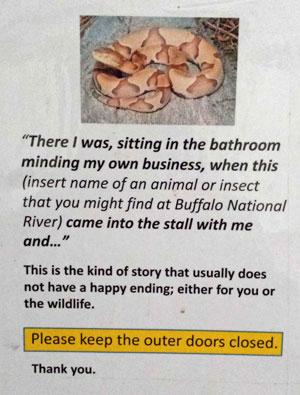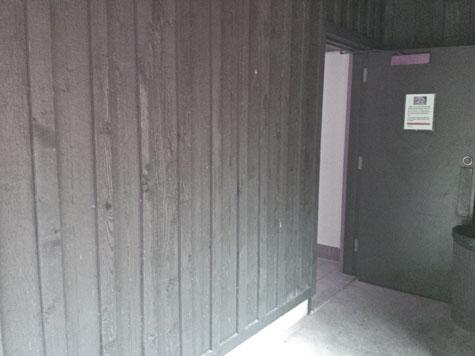Throughout the National Park System, and other public lands across the nation, arguably the most popular facilities are also the most utilitarian: comfort stations. They come in a variety of styles, from modern to rustic, but the same guideline applies to them all'please keep the outside door closed. Failing to do so can lead to some classic examples of the Law of Unintended Consequences.
Now why, you might wonder, would anyone prop the door open in the first place...but if they do, does it really matter, unless modesty is at risk?
The answer to the first question usually involves an attempt to make the "station" a bit more, well, comfortable. Unless they're located inside another building such as a visitor center, few such facilities are air-conditioned, and in warmer climes the interior can get a bit toasty. In the case of the increasingly rare old-fashioned pit toilets which have no plumbing at all, the atmosphere may occasionally be both toasty and just a tiny bit pungent.
An easy solution in the minds of some well-intentioned visitors is to just prop the door open as they depart, with the goal of promoting some air exchange. Doing so requires defeating the various kinds of springs and other closing devices intended to keep the door closed, but the spirit of public service inspires a variety of solutions, and everything from large rocks to trash cans have been employed as door stops.
Although it may seem like a good idea, this is one situation when an "open door" policy is definitely not desirable.
So, what's wrong with an attempt to encourage "out with the bad air, in with the good?"
I witnessed one example of those unintended consequences some years ago at the Willow Beach Ranger Station in Lake Mead National Recreation Area. The building included a small exhibit and information area on one end and the comfort station, which was available 24 hours a day, on the other. The rangers' limited office space was located in the middle of the structure, so it shared a common wall with the men's room.
Early one summer morning, I had just walked into the office and had noticed an unoccupied car parked out front, a normal occurrence when a visitor stopped to use the comfort station. Through the shared wall I heard the familiar sound of the stall door in the men's rest room bang shut, but it was followed almost immediately by a blood-curdling scream.
I dashed out the door just in time to see a middle-aged man struggling mightily to make a hasty departure from the men's room. His exit was hampered by the not very successful attempt to simultaneously run and pull his trousers back to their upright and locked position, so his freedom of motion was severely restricted. Other than his awkward situation, however, I couldn't see any obvious reason for his panic.
The poor guy made it about halfway to his car before he got his act together, at which point he stopped, hands on knees, gasping for breath. I wasn't sure if he was having a heart attack or some other medical problem, but since I could now approach him without mutual embarrassment, I circled around and asked the least compromising question I could think of under the circumstances: 'Can I help you, sir?'
The man noticed me for the first time and raised a trembling hand back toward the restroom door. In between his ragged breaths, he was able to utter a single, quavering word: "Rattlesnake!'
I glanced back toward the men's room door and saw that someone had propped it open during the night, using a large rock as a doorstop. Since the room was not air-conditioned, this happened occasionally, although with even nighttime summer temperatures often hovering near the century mark, any 'cooling' effect provided by the open door was questionable.
My theory about the situation was confirmed as the visitor calmed down and explained that he had gone into the stall, closed the door, and was preparing to take his position on the appropriate plumbing fixture, when he heard the distinctive warning buzz of a rattlesnake. As he turned his head, he spotted the reptile coiled up next to the wall, in the corner of the stall.
The snake, seeking a secluded spot to escape the heat, had crawled in through the open door and found just the place on the relatively cool concrete floor in the corner of the stall. Having gotten comfortable, the reptile clearly objected to sharing its space with anything, or anybody, else.

This sign, posted inside a comfort station door at the Buffalo National River, offers some fine advice! Jim Burnett photo.
Now that the man had escaped unscathed, he was able to see some humor in his situation. Shaking his head, he commented, 'I'm sure glad I didn't get bitten, but I'm really glad I don't have to explain to anybody how I managed to get bitten on the part of my anatomy that was closest to that snake!'
Just for the record, I silently agreed, and was very glad I didn't have to administer first aid in this particular situation.
This was not an isolated incident, although the cast of characters in such encounters can range from snakes and skunks to a variety of flying and stinging insects. I was reminded of the above tale during a visit last week to the Buffalo National River in the Arkansas Ozarks, where I spotted the sign shown to the right, posted on the inside of a comfort station door at the Buffalo Point campground. It sums up the situation very nicely.
So, feel free to enjoy these amenities provided for your convenience during your next park visit, but as you leave, please close the door.
By doing so, you'll greatly reduce the odds that those who come after you will have a close encounter of the worst kind ... and that's a comforting thought.
Portions of this story were adapted from the book, Hey Ranger! True Tales of Humor and Misadventure from America's National Parks.


 Support Essential Coverage of Essential Places
Support Essential Coverage of Essential Places







Comments
I really should not have read this at work as I burst out laughing.
BUSTED:)!!!!!
This reminded me of a true story that should produce a good laugh on a Thursday. I had a friend while in high school who was a ham radio operator. He got a job one summer as a lifeguard at a state park swim beach. He built a small radio receiver and attached it just under the seat in the women's side of a pit privey near his lifeguard station from which he could watch the pottyhouse door.
He'd see a woman enter the little facility and would wait a few moments for her to get settled before picking up a microphone and saying something like, "Uh, hey, lady --- will you move over to the next hole? We're painting down here."
You can probably easily imagine the next part of this story.
Great story, Lee! Thanks for sharing.